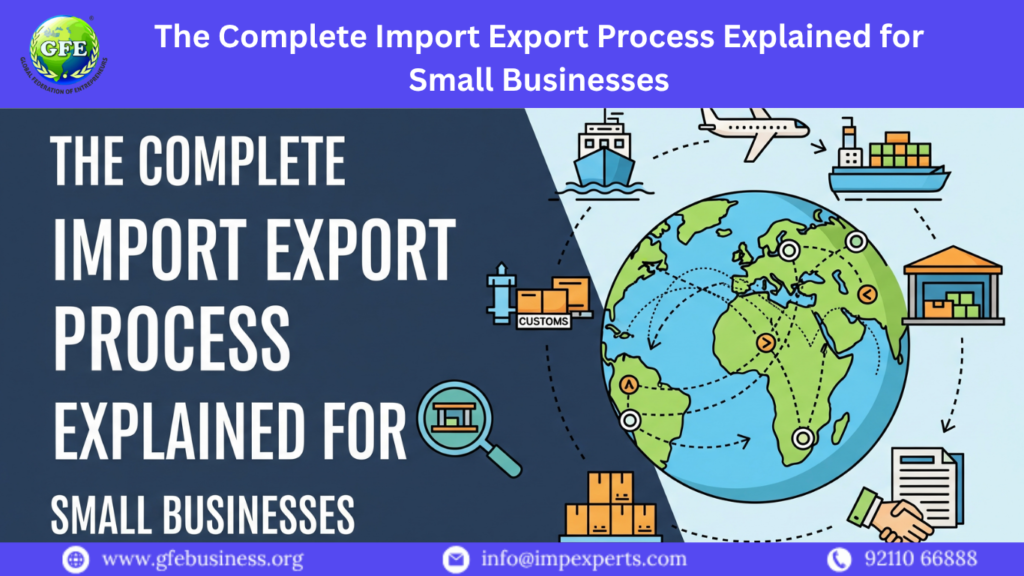Thinking about taking your small business global? You’re not alone.
Thousands of Indian entrepreneurs are now expanding beyond domestic markets through international trade. But the real difference between those who succeed and those who get stuck is this: understanding the complete import export process.
At GFE Business, we’ve helped small business owners across India — from Rajkot to Kolkata, Surat to Pune — enter the world of import and export with confidence and clarity. If you’re new to global trade, this blog will walk you through the exact steps you need to follow to go from local seller to international trader.
Step 1: Legal Business Registration
You can’t trade internationally without a registered business entity. Choose one of the following:
Proprietorship – Simple and ideal for solo businesses
Partnership or LLP – Good for joint ventures
Private Limited Company – Ideal for scaling or getting investor funding
Make sure your PAN card, GST registration, and business bank account are set up under the same business name.
Step 2: Obtain Your IEC (Import Export Code)
This is the first license you’ll need.
Issued by the Directorate General of Foreign Trade (DGFT), the IEC is a 10-digit code required for both imports and exports. Without it, you can’t clear goods through customs.
Application is done online, and you’ll need:
PAN card
Business address proof
Bank account details
Digital signature (DSC)
Once approved, your IEC remains valid for life.
Step 3: Select the Right Product
Success in global trade depends heavily on your product choice. Whether you plan to export handicrafts, textiles, spices, or import electronics, packaging material, or tools, consider:
Global demand and trends
HS Code and customs duties
Local sourcing and logistics
Legal restrictions (banned/restricted items)
Many small businesses start with niche or value-added products that are hard to find in foreign markets.
Step 4: Market Research & Buyer/Supplier Identification
Once your product is finalized:
For exports, research target countries using ITC Trade Map, DGFT reports, or Google Trends
For imports, compare global suppliers on platforms like Alibaba, GlobalSources, and 1688
You can also attend B2B exhibitions, contact export promotion councils, or use LinkedIn and email marketing to reach international buyers directly.
Step 5: Set Up a Trade-Ready Bank Account & AD Code
Ensure your current account is with a bank authorized to handle foreign exchange (AD bank).
Next, get your AD code registered at your designated port of export. This links your IEC and bank to the customs office — a requirement for shipping clearance.
Step 6: Understand HS Codes and Taxes
Every traded product has an HS (Harmonized System) Code, which affects:
Customs classification
GST applicability
Import/export duty
Legal compliance
Small businesses often skip this step and end up overpaying duties or facing clearance delays. Use the CBIC database or consult a CHA (Customs House Agent) to classify your product correctly.
Step 7: Documentation: The Backbone of Trade
Even the best product won’t move if your paperwork is wrong.
As a small business, learn to prepare these documents or work with a professional:
| Document | Purpose |
|---|---|
| Proforma Invoice | Offer to the buyer |
| Commercial Invoice | Final sales document |
| Packing List | Shipment breakdown |
| Bill of Lading / AWB | Proof of shipping |
| Certificate of Origin | Required in many countries |
| Insurance Certificate | Especially for CIF shipments |
Accurate documentation helps you claim incentives, get paid, and avoid penalties.
Step 8: Shipping & Logistics
Your next decision: how to move your goods.
Sea Freight – Best for bulk, cheaper, slower
Air Freight – Faster, costlier, ideal for perishables or light items
Courier – Good for samples or small exports
Choose the right Incoterms (FOB, CIF, EXW, DDP) to define who handles costs and risks at each stage.
For small businesses, starting with FOB or CIF is generally safer and easier to manage.
Step 9: Customs Clearance
Your CHA or logistics agent will help with:
Filing the Shipping Bill (for exports)
Filing the Bill of Entry (for imports)
Paying duties (for imports)
Ensuring correct HSN declaration and port protocols
Stay involved in this process — it’s essential to your cash flow and delivery timelines.
Step 10: Receive or Deliver Goods & Confirm Payment
For exports, once your goods reach the buyer:
Track delivery using shipping documents
Ensure payment release as per agreed terms (TT, LC, escrow, etc.)
For imports, inspect the goods on arrival and handle post-clearance documentation like FIRC (Foreign Inward Remittance Certificate) and GST returns.
Step 11: Claim Government Benefits
Small businesses in India can access incentives such as:
RoDTEP – Refunds duties on exported goods
Duty Drawback – Partial duty refunds
Interest equalization scheme – Reduced loan interest
MSME schemes – Preferential rates, training, and subsidies
Ensure your shipping bills are linked to your IEC, and submit claims through the DGFT portal.
Common Mistakes Small Businesses Should Avoid
| Mistake | Impact |
|---|---|
| Skipping IEC registration | Total customs rejection |
| Using wrong HS Code | Delayed or failed clearance |
| Poor documentation | Risk of penalty or shipment hold |
| No supplier or buyer verification | Payment loss |
| Not tracking incentives | Loss of margin |
At GFE Business, we guide small business owners step-by-step to avoid these errors — even after the training ends.
Final Words
The import export process may look complex at first, but with the right steps, small businesses in India can easily tap into global opportunities.
You don’t need a huge budget or big office — just proper guidance, verified documentation, and a clear action plan. The team at GFE Business offers hands-on training and post-course support to help you launch confidently.
📞 Want to take your small business global with expert guidance?
Visit 👉 www.gfebusiness.org and explore our complete import export training programs.








